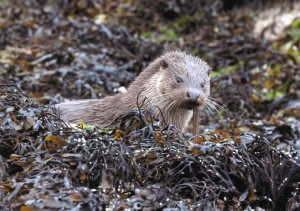 Otters seem to have been in the news recently, particularly after the filming of them in the Beauly Firth on the recent BBC’s Autumn Watch series. They must be one of the most difficult animals to see in the countryside, partly because they are so unpredictable. For example some animals are nocturnal, almost completely so, such as the badger. Foxes and pine martens are also mainly nocturnal but can, occasionally, be seen in daylight especially when they are not disturbed by such activities as shooting. The otter, according to most books, is also nocturnal but in practice this is far from the case. One of the problems the otter has is the amount of food it needs, mainly live fish, especially eels that they seem partial to. Whatever the food it does mean feeding during the day if the food is short, especially if the otters are un-disturbed.
Otters seem to have been in the news recently, particularly after the filming of them in the Beauly Firth on the recent BBC’s Autumn Watch series. They must be one of the most difficult animals to see in the countryside, partly because they are so unpredictable. For example some animals are nocturnal, almost completely so, such as the badger. Foxes and pine martens are also mainly nocturnal but can, occasionally, be seen in daylight especially when they are not disturbed by such activities as shooting. The otter, according to most books, is also nocturnal but in practice this is far from the case. One of the problems the otter has is the amount of food it needs, mainly live fish, especially eels that they seem partial to. Whatever the food it does mean feeding during the day if the food is short, especially if the otters are un-disturbed.
Such was the case over the Autumn Watch otters as a family party was filmed in Inverness. Judging by the lighting it looked as if it was either early at first light or much later in the day as the light was fading. The interesting part about the filming was that the animals were on the base of one of the supports of the Kessock Bridge. It looked to me as if it was from the north side of the firth and a spot I know well because I used to use it by sitting in the car and watching the birds go past or as they were feeding. I confess that I never ever saw an otter. In the film they were taking the shell-fish, could they have been mussels, off the base of the bridge. There was a family party of them and the cubs could clearly be seen.
My own sightings of them in daylight have been in the same opportunist way such as the one at Loch Bunachton just south of Inverness. I was looking through the telescope to see what water birds were around when there was a commotion in the water under a reed bed. The commotion came from an otter that was obviously fishing. I watched it for some time and that was in the middle of the afternoon – so much for them being nocturnal, according to the books. On another occasion I was on the Isle of Mull and one was fishing in the seaweed zone on the edge of the water and it came out with an eel that it promptly ate in front of me. In all my encounters with them during the day I have always accidently come across them rather than any pre-determined plan.
The other way to see them is at first or last light and during the summer when the nights are short, otters have little choice but to feed during the day. Many people have seen otters along the River Ness in Inverness early in the morning in the summer months and no doubt they breed somewhere along the banks in a secluded spot, if there is one there. These days otters are fully protected which has not always been the case and in the Highlands the persecution in the past has been relentless. Traps and shooting were at one time the norm, mainly because of their predation on fish, especially in fisheries. There was even a bounty on them for many years along with the bounty on foxes, pine martens and badgers.
